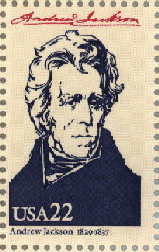Andrew Jackson 1767-1845 A brief biography
The People's Inaugural: January - March 1829
 After a month of seclusion, on January 18, Jackson began a three week trip
to Washington. He was dressed in mourning, a 'weeper' of black crepe around
his tall hat and hanging down his back. He was greeted by huge throngs
of cheering people the whole way, and he slipped by the crowd near Washington
to avoid the crush.
After a month of seclusion, on January 18, Jackson began a three week trip
to Washington. He was dressed in mourning, a 'weeper' of black crepe around
his tall hat and hanging down his back. He was greeted by huge throngs
of cheering people the whole way, and he slipped by the crowd near Washington
to avoid the crush.
Washington's rooming houses were filled well beyond their normal capacity. Daniel Webster said people came from 500 miles away and seemed to think that the country had been "rescued from some dreadful danger".
The inaugural address was one of the shortest in history. An eminent South Carolinian called it "chaste patriotic ... and dignified", while the Democratic press said it "breathes throughout the pure spirit of republicanism of the Jefferson school". Jackson was praised for his stately composed dignity and elegant bearing. Even Daniel Webster had earlier called Jackson the most "presidential" looking of the presidential aspirants.
The inaugural reception was a riotous affair with thousands attending, and Jackson in need of protection against being crushed to death. Several thousand dollars worth of china and glassware were smashed and finally, to draw the crowd outside, it was necessary to bring the tubs of punch and other refreshments outside. The Argus of Western America said "It was a proud day for the people, General Jackson is their own president", and the Argus called him "plain in his dress, ... unaffected and familiar in his manners...".
It takes a rare man to be seen as "stately and elegant", and at the same time be seen by poor frontier farmers as "one of the people". That was much of the attraction of Andrew Jackson.
The personal make up of Jackson's cabinet was a problem from the start. Vice President John C. Calhoun was intensely ambitious at this stage of his career. He had done much to overthrow Adams, such as setting up Duff Green's Telegraph, the strongest national party organ seen up to the time. It is thought that there was some sort of agreement for Jackson to serve one term, and then support Calhoun for 1832.
He had feeling his influence wane, and his future threatened. The Secretary of State, that stepping-stone to the presidency did not go to Calhoun's ally Virginian Littleton W. Tazewell, as Calhoun wished. Instead it went to Martin Van Buren - as much a Northerner as Adams, also ambitious, and with a reputation for being a political "Magician", or the "Red Fox of Kinderhook".
Meanwhile, Calhoun's political orientation was changing. Before he had been a strong nationalist, but now he was leaning towards the most extreme states rights partisans - the Nullifiers.
He was the anonymous author of South Carolina's Exposition and Protest, a lawyerly argument claiming the state had a right, under some circumstances, to declare a federal law null and to disregard it. This proclamation, aimed at the recent tariff bill, was the opening act of the Nullification Crisis. While Calhoun's partisanship was hidden, Jackson's total opposition to such measures was as yet unknown, and he too was seen as a states righter.
Then there was the old business of Calhoun, in 1818, being among those calling for Major General Jackson's disciplining for seizing the Spanish territory of Florida. Robert V. Remini argues persuasively that Jackson was encouraged in this by President Monroe, through broad but indirect hints. Thus Monroe got a fait accompli that lead to Florida's incorporation as a U.S. territory. Jackson, meanwhile "took the heat" when Henry Clay and others had Jackson called before Congress, and Monroe remained silent.
